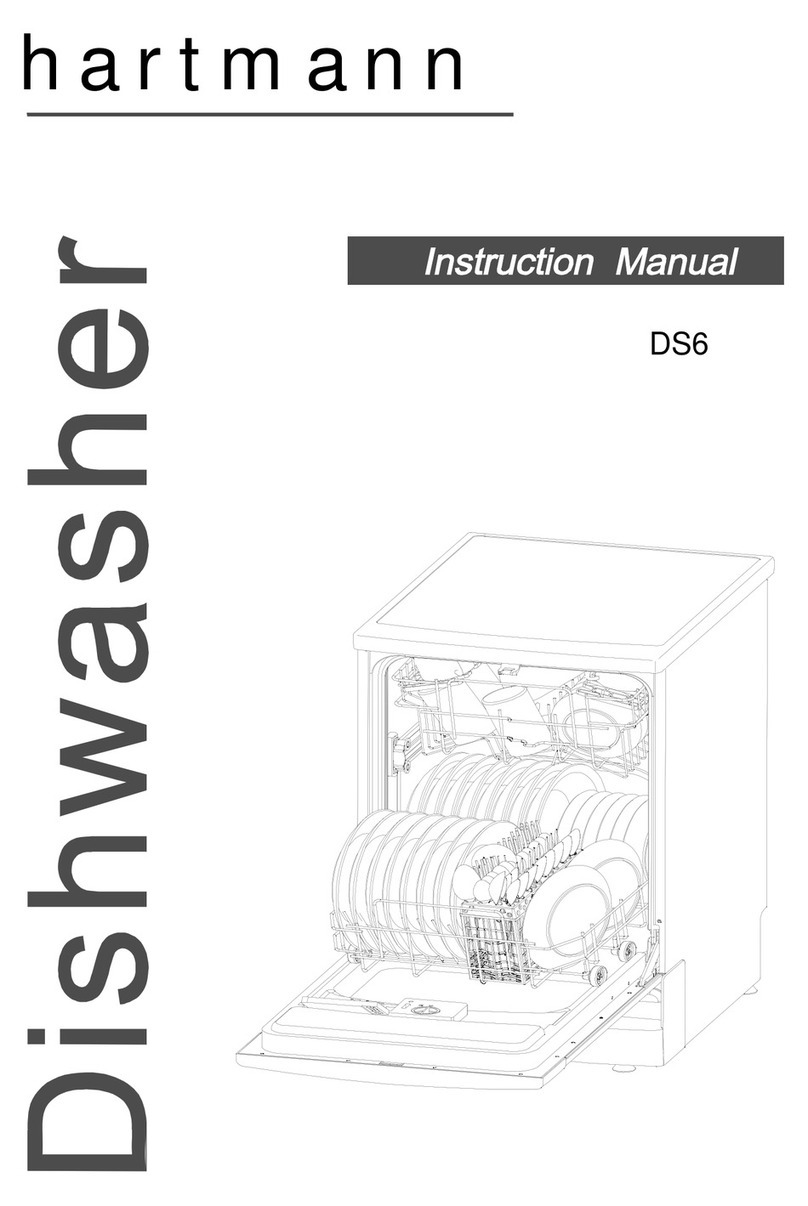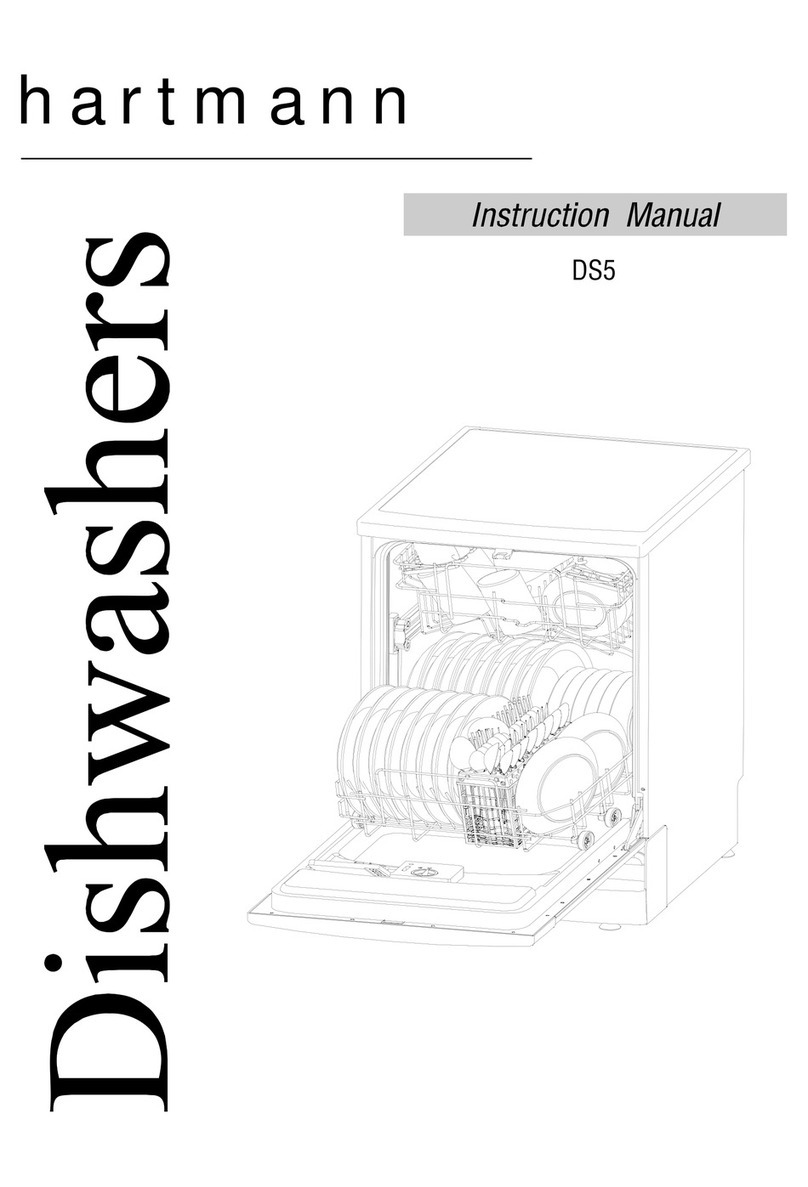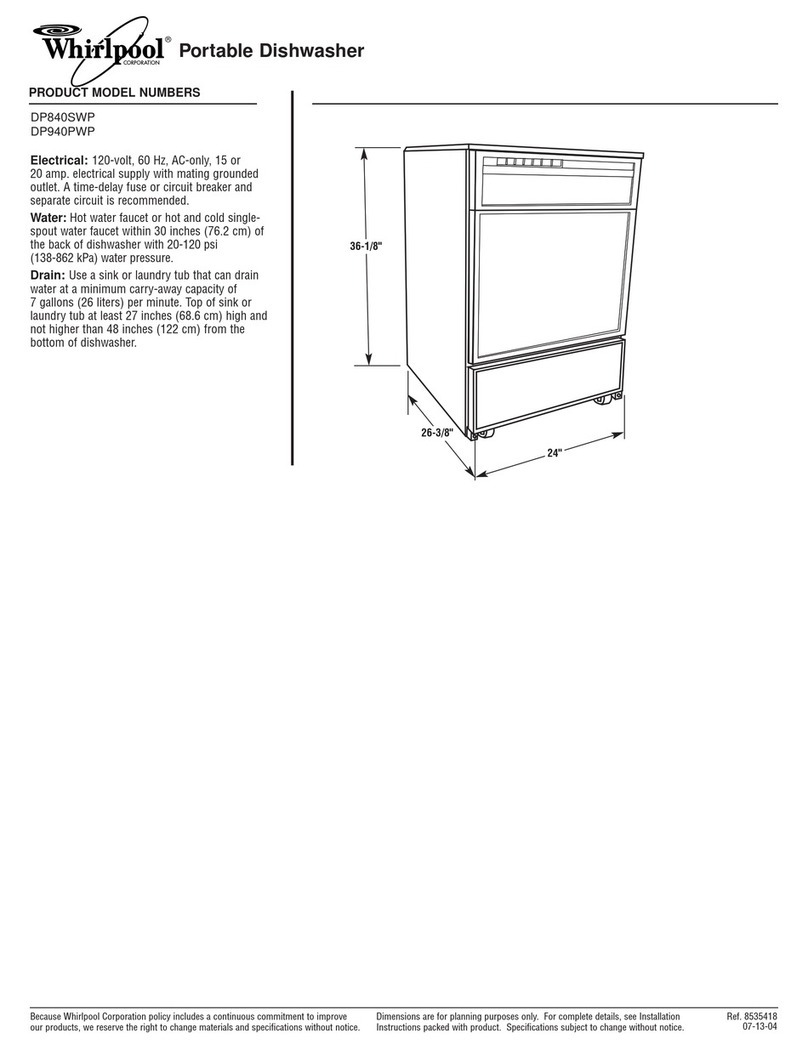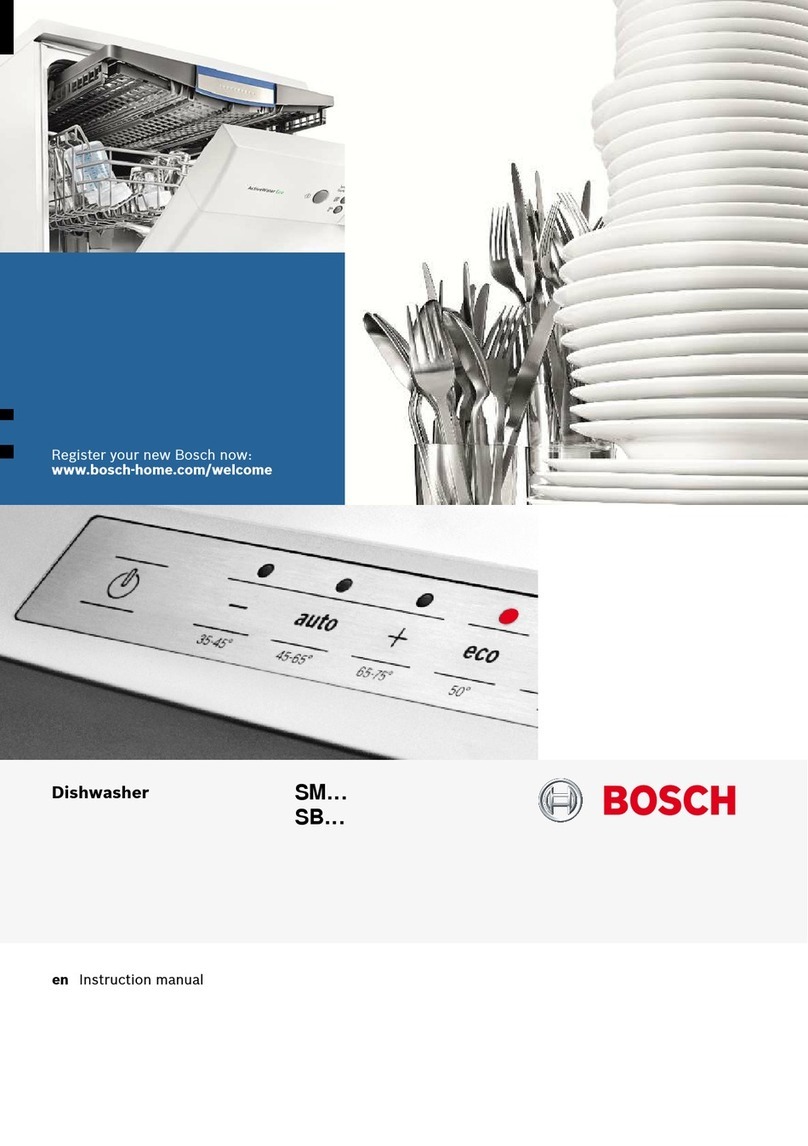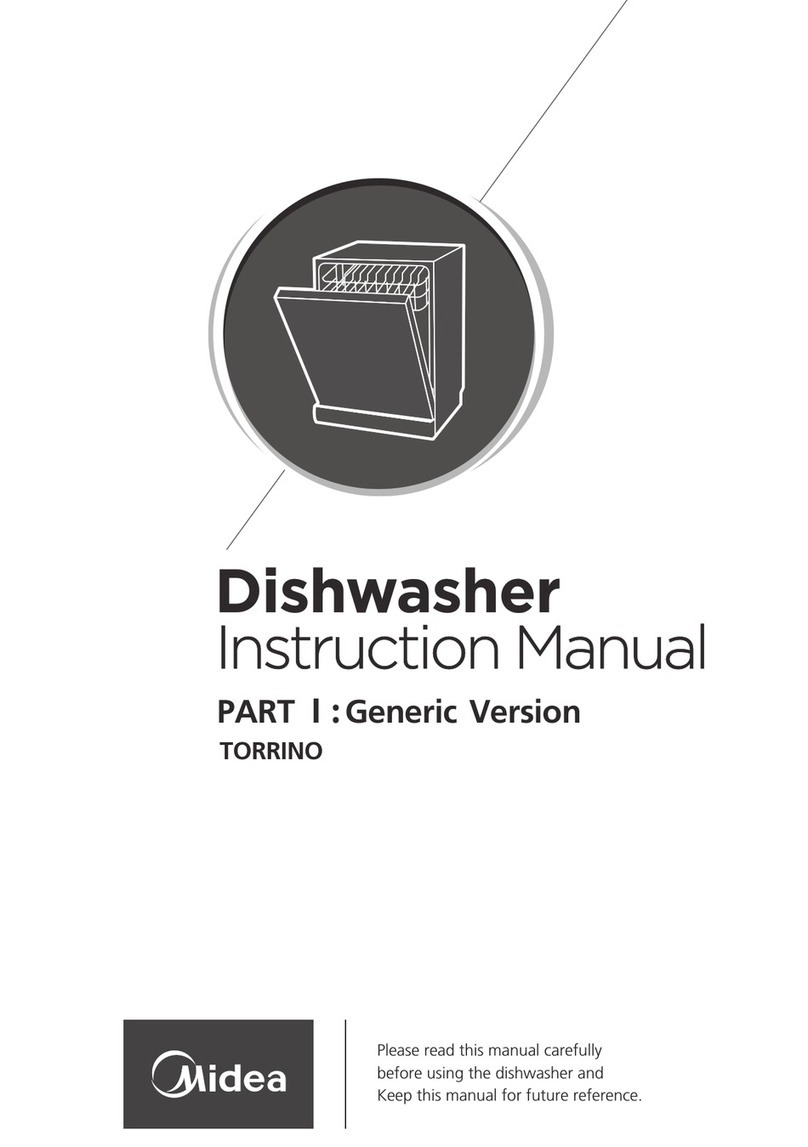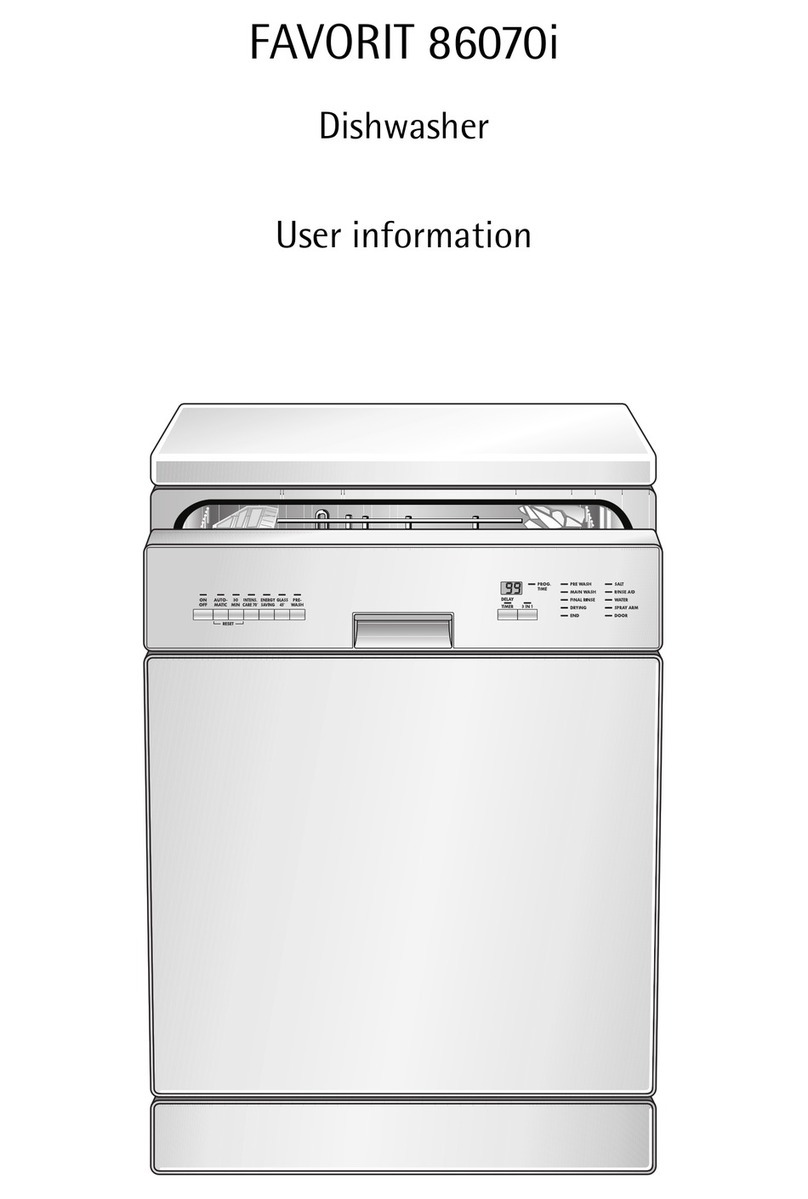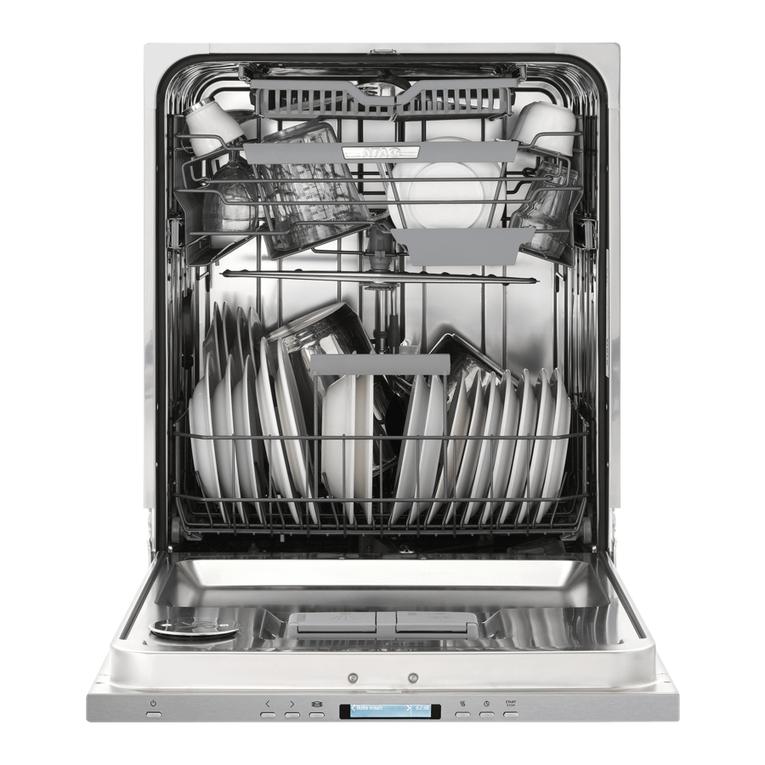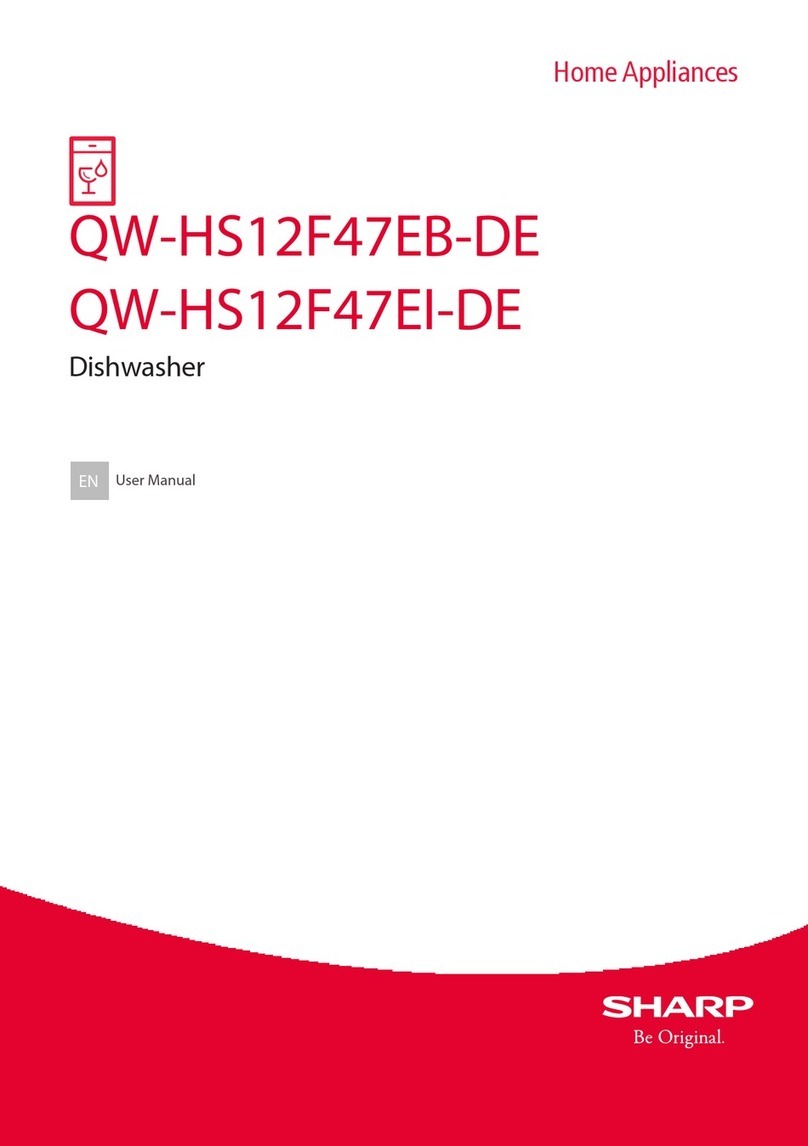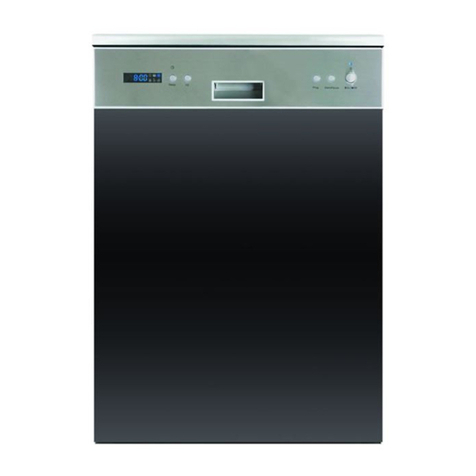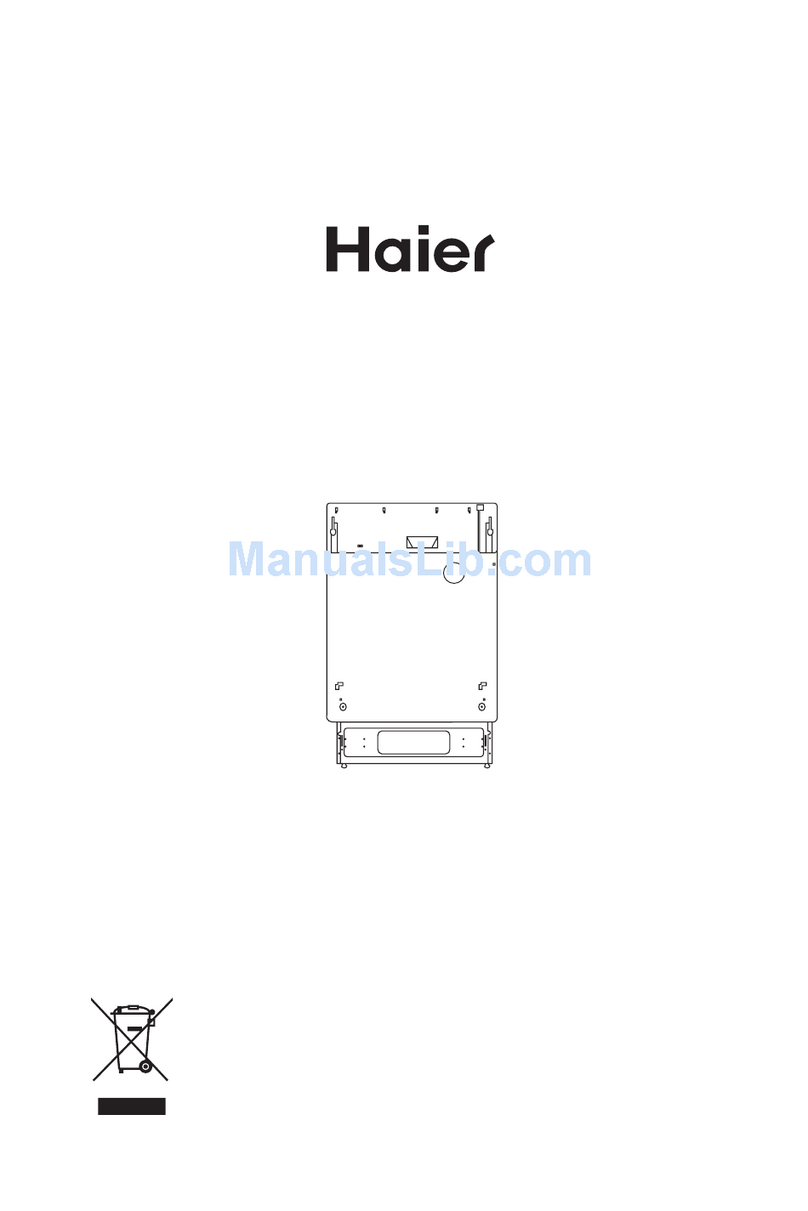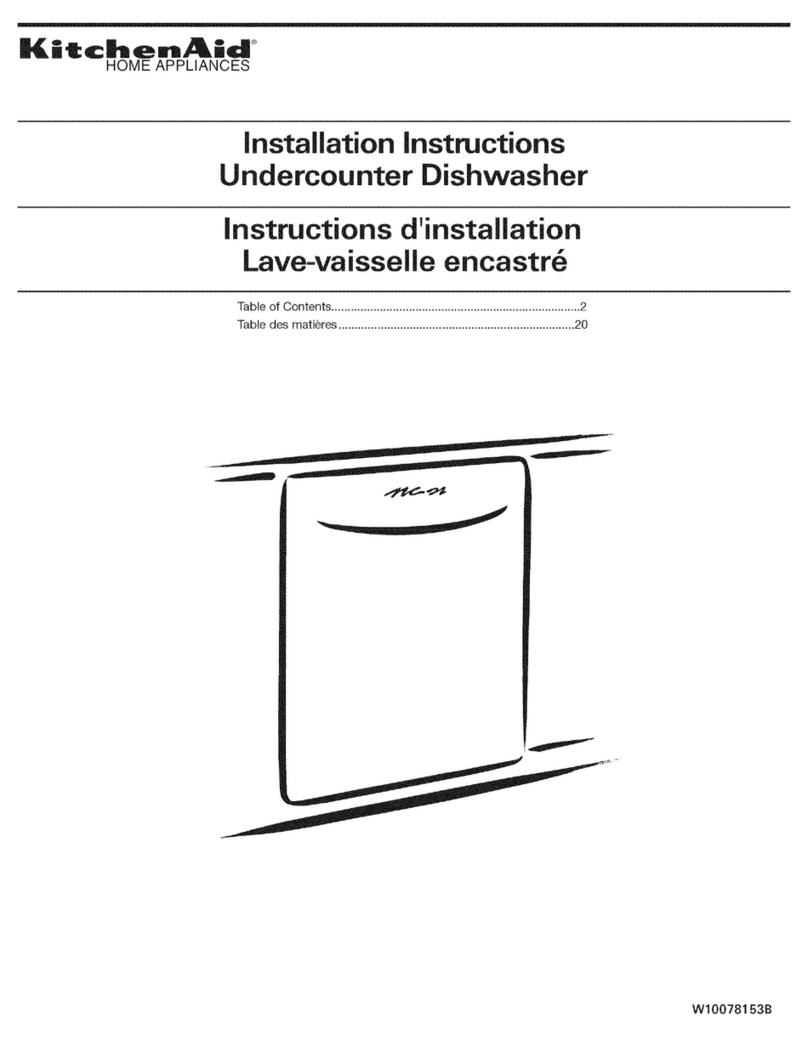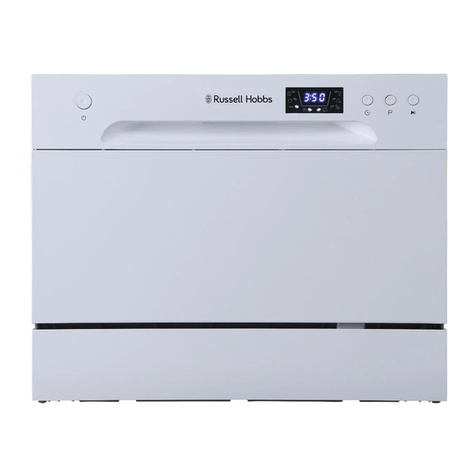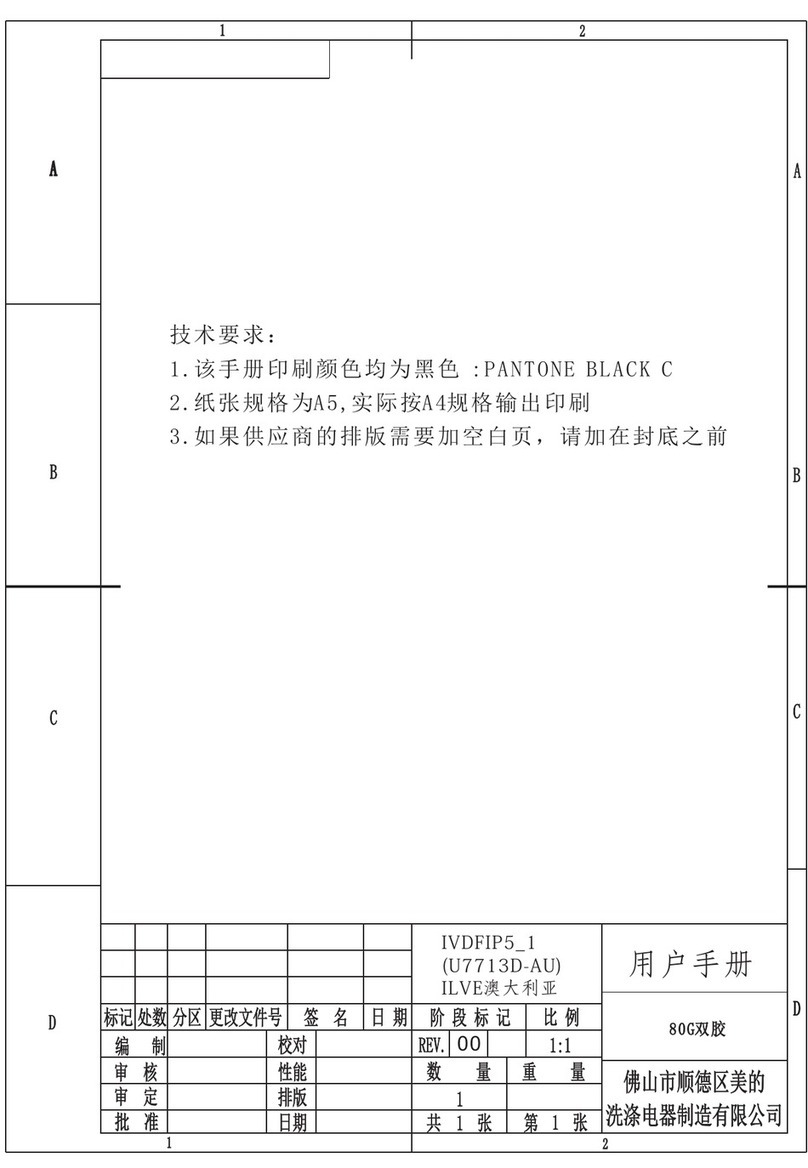Hartmann DS4 User manual

DS4
hartmann

This manual contains sections of Safety
Instructions,Operating Instructions,
Installation Instructions and Troubleshooting
Tips etc. Carefully reading it before using the
dishwasher will help you to use and maintain
the dishwasher properly.
To review the section on Troubleshooting Tips
will help you to solve some common problems
by yourself and not need to ask for the help of
professional technicians.
The manufacturer, following a policy of constant
development and up-dating of the product, may
make modifications without giving prior notice.
ControlPanel........................2
DishwasherFeatures................. 3
WashCycleTable.................... 4
Error Codes
Detergent...........................5
RinseAid......................... 6
Loading the Dishwasher Rack . . . . . . . . 7,8
FilteringSystem..................... 9
CaringfortheDishwasher.......... ,11
.......... ........ ...... 4
.........9
............. 9
.10
Not suitable for the dishwasher
Turning on the Appliance
AboutElectricityconnection..........11
WaterConnection...................12
...............12
Drain hose Connection
Beforecallingforservice.......... 13,14
..................1
Technical information. . . . . . . . . . 15........

This appliance must be grounded. In the event
of a malfunction or breakdown, grounding will
reduce the risk of electric shock by providing a
path of least resistance of electric current. This
appliance is equipped with a cord having an
equipment-grounding conductor and a grounding
plug. The plug must be plugged into an appropriate
outlet that is installed and grounded in accordance
with all local codes and ordinances.
Improper connection of the equipment-
grounding conductor can result in a risk
of electric shock. Check with a qualified
electrician or service representative if you
are in doubt whether the appliance is
properly grounded. Do not modify the plug
provided with the appliance; If it is not fit
for the outlet. Have a proper outlet installed
by a qualified electrician.
Under certain conditions, Hydrogen gas may be produced in a hot-water system that has not been
used for two weeks or more. HYDROGEN GAS IS EXPLOSIVE.
If the hot-water system has not been used for such a period, before using the dishwasher turn on all
hot-water faucets and let the water flow from each for several minutes. This will release any
accumulated hydrogen gas. As the gas is flammable, do not smoke or use an open flame during this
time.
1
Keep children away from detergent and rinse aid, keep
child away from the open door of the dishwasher,
there could still be some detergent left inside.
ren
Do not abuse, sit on, or stand on the door or dish
rack of the dishwasher.
Do not touch the heating element during or
immediately after use.
Do not wash plastic items unless they are marked
dishwasher safe or the equivalent. For plastic
items not so marked, check the manufacturer's
recommendations.
Use only detergent and rinse additives designed
for an automatic dishwasher. Never use soap,
laundry detergent, or hand washing detergent
in your dishwasher. Keep these products out of
the reach of children.
During installation, the power supply must not
be excessively or dangerously bent or flattened.
The door should not be left in the open position
since this could present a tripping hazards.
Do not tamper with controls.
Do not operate your dishwasher unless all
enclosure panels are properly inplace. Open
the door very carefully if the dishwasher is
operating,there is a risk of water squirting out.
Do not place any heavy objects of stand on the door
when it is open. The appliance could tip forward.
When loading items to be washed:
1) Locate sharp items so that they are not likely to
damage the door seal;
2) Load sharp knives with the handles up to reduce
the risk of cut-type injuries.
3 Warning:Knives and other utensils with sharp points
must be loaded in the basket with their points down
or placed in a horizontal position.
)
When using your dishwasher, you should prevent
plastic item from contacting with heating element.
If the supply cord is damaged, it must be replaced
by the manufacturer or its service agent or a
similarly qualified person in order to avoid a
hazard.
Please dispose of packing materials properly.
Use the dishwasher only for its intended function.
Remove the door to the washing compartment when
removing an old dishwasher from service or discarding it.
The appliance is not intended for use by young
children or infirm persons without supervision.
Dishwasher detergents are strongly alkaline,they
can be extremely dangerous if swallowed.Avoid
contact with skin and eyes andkeep children away
from the dishwasher when the door is open.
Young children should be supervised to ensure that
they do not play with the appliance.
Check that the detergent receptable is empty after
completion of the wash cycle.
Other means for disconnection from the supply must
be incorprated in the fixed wiring with at least 3mm
contact separation in all poles.
The appliance is to be connected to the water mains
using new hose sets and that old hose-sets should
not be reused.
The maximum number of place settings to be washed
is 12.
The maximum permissible inlet water pressure is 1Mpa.
The minimum permissible inlet water pressure is 0.04Mpa.

To get the best performance from your dishwasher,read all operating instructions before using it for the
first time.
2
810 5
3
4
2
0
0
0
0
Washing Program: Intensive, Normal, Economic, Rinse, Glass,
Rapid and Prewash.
Information Display: You can get information from it
such as washing program, Error, Door-Open and etc.
Washing Phase: the 1st sign is prerinse, the 2nd is main wash,
the 3rd is rinse and the last one is drying, they will run and
alternate when washing
State Information: the 1st sign means
the display is remain time of washing,
the 2nd sign means the delay time,
the3rdmeansthedisplayoftemperature.
Digital Display: display the remaining time , error code
and the delay time.
Choice of Temperature: You can choose different
temperature, then the intensity of washing will be
changed
It is dangerous to open the door when washing, maybe burned by hot water.
1
2
3
4
10
7
8
9
Program Button: Select different program according to
the soiled level, such as Intensive, Normal and Rinse.
Language Button: Select English, Italy
and Spanish languages by pressing the button.
France, German,
Start / Pause Button: Press this button to start or stop the
dishwasher, the light will come on when starting.
Power Switch: Turn on/off the power supply.
Display Window: Program remaining time, delay time,
running indicator, temperature of water, fault codes and etc.
Delayed Button: Press this button to set the delayed
hours for washing. You can delay the start of wash up to
9.5 hours, one press on this button delays the start by
half an hour.
5
11
Rinse Aid Warning light: rinse aidAdd more as the
indicator on the front panel lights up.
Temperature Button: Select different temperature of
washing by pressing the button.
6
Door Handle: Pull it to open the door. The machine will stop
when the door is opening.
Half washing key-press:To select half washing.
(Optional half washing means that the lower spray arm
does not run,so you should load the upper basket only).
Half washing light:To come on when select the
Half wash.(option)
1
11 976

3
1
2
3
4
5
6
Draw out the lower and upper basket, load the dishes and
push them back. It is commended that loading the lower
basket first, then the upper one.
Insert the plug into the socket.
The power supply is 220-240VAC 50HZ, the specification
of the socket is 2 250VAC.1A
Press the ON/OFF button
According to the soil level to choose the desired program
by pressing the program selection button.
Press the Start/Pause button to start the washing.
With a little force to ensure the door is properly closed.
NOTE: A click could be heard when the door is closed
perfectly.
Press the Start/Pause button to pause washing.
Press the programme button to select the desired
programme.
Press the button to start washing.
Start/Pause
1
2
3
When the dishwasher is running, you want to change the using
programme, you should do according the following step.
NOTE:
If you open the door when washing, the machine
willdelay start forseveral seconds, whichwillmake the
dishwasher work much better.
At the end of a wash cycle, the time display will flash for 8
seconds while the buzzer sound. However, when the delay
start funtion is activated, the time display will flash for
8 seconds, but the buzzer will not sound.
11
10
1
2
3
4
5
6
7
8
9
Upper Basket
Spray Arms
Lower Basket
Detergent Dispenser
Silverware Basket
Main Filter
Cup Shelf
5
6
7
8
Rinse Aid Dispenser
Coarse Filter
Drain pipe connector
Inlet pipe connector
9
10
11
3
2
14

4
For dishes that need to rinsed
and dried only
5/25 g.
5/25 g.
Pre-wash
wash(50 )
Wash (50/60/70℃)
Rinse
Rinse (65/70/70℃)
Drying.
℃
Pre-wash of dishes pots and
pans while waiting for the
load to be completed after the
subsequent meal.
For the heaviest soiled loads,
such as pots, pans, casserole
dishes and dishes that have
been sitting with dried food on
them for a while.
For heavy soiled loads,
such as , plates, glasses
and lightly soiled pans.
standard daily cycle.
pots
15 g.
For lightly soiled loads, such
as glasses, crystal and fine
china.
15 g.
A shorter wash for lightly
soiled loads that do not need
drying.
*
(AS/NZS 2007.1)
Pre-wash
Pre-wash
Pre-wash
Wash (50/60℃)
Rinse
Rinse (65/70℃)
Drying.
Pre-wash
Pre-Wash
Wash(40/ 50
*
℃)
Rinse 60℃
Drying.
Wash(45/60℃)
Rinse
Rinse (60/70℃)
Drying.
Pre-wash
Wash (40/50℃)
Rinse
Rinse (60/70℃)
Drying.
Pre-wash
Wash (40/50℃)
Rinse
If overflow occors, turn off the main water supply before calling a service. If there is water in the base pan because of an overfill
or small leak, the water should be removed before restarting the dishwasher.
*
Economic (50℃) : Standard program for energy and water labeling.
For normal soiled loads,
such as , plates, glasses
and lightly soiled pans.
standard daily cycle.
pots
5/25 g.
Longer inlet time.
Faucets is not opened.
Longer draining time.
The installation position of the drain pipe is too high.
Longer heating time,
but not reaching required temperature
Malfunction of temperature sensor or of heating element.
Overfilled.
Too much inlet water. .
Failure of temperature sensor
Short circuit or break of temperature sensor
Open circuit or break of temperature sensor
Failure of temperature sensor

5
If the water isn't too hard, you may also prevent the formation of deposits by adding detergent.
The dispenser must be refilled before the start of each wash cycle following the instructions provided in the" Wash Cycle
Table".Your dishwashers than conventional dishwashers. Generally, only one tablespoon of
detergent is needed for a normal wash load. Also, more heavily soiled items need more detergent. Always add the detergent just
before starting dishwasher, otherwise it could get damp and will not dissolve properly.
use less detergent and rinse aid
To remove hard water spots, try the following:
Run dishes through a normal wash program.
Remove all metal dishware, such as cutlery, pans, etc.,
from the dishwasher.
Do not add detergent.
Pour two cups of vinegar into a bowl and set the bowl face
up on the lower rack of the dishwasher.
Run the dishes through a normal wash program.
If this doesn't work, try the same process with 1 / 4 cup of
citric acid crystals instead of vinegar.
Dishwasher detergent is corrosive! Take care to keep it out
of reach of children.
Use only detergent specifically made for use in dishwashers.
Keep your detergent fresh and dry. Don't put powder detergent
into the dispenser until You're ready to wash dishes.
Detergent
for pre-wash
Detergent
for main wash
Follow the detergent manufacture's recommendation
on detergent.

6
A measured amount of rinse-aid is released during the final rinse. As with detergent, the amount
of rinse-aid needed for your dishes depends on the hardness of the water in your area. Too much
rinse-aid can result in lather of foaming and cause cloudiness or steaks on your dishes. If the
water in your area is very soft, you may not need rinse-aid. If you do,you can dilute the rinse-aid
with an equal amount of water.
The rinse-aid dispenser has six or four settings. Always start with the dispenser set on " 2 ". If
spots and poor drying are problems, increase the amount of rinse aid dispensed by removing the
dispenserlid and rotating the dial to "3". If the dishes still are not dryingproperlyorarespotted,
adjust the dial to the next higher number until your dishes are spot-free. We suggest you
to set on "4" .(Factory value is "4".)
If there is no rinse-aid warning light in the control panel, you can judge the amount of rinse-aid by the color of the optical level
indicator "D" located next to the cap. When the rinse-aid container is full, the whole indicator will be dark .As the rinse-aid
diminishes, the size of the dark dot decreases. You should never let the rinse aid get below 1 / 4 full.
As the rinse aid diminishes, the size of the black dot on the rinse
aid level indicator changes, as illustrated below.
Full
3/4full
1/2full
1 / 4 full - Should refill to eliminate spotting
Empty
To open the dispenser, turn the cap to the "open" (left)
arrow and lift it out.
Pour in rinse -aid into the container is fill (approx . 140 ml) ,
Being careful not to overfill.
Replace the cap by inserting it aligned with "open" arrow
and turning it to the closed (right) arrow.
The rinse aid is released during the final rinse to prevent water
from forming droplets on your dishes that can leave spots and
streaks. It also improves drying performance by allowing water
to "sheet" off the dishes.
Your dishwashers are designed to use liquid rinse aids. The
rinse aid dispenser is located inside the door next to the
detergent dispenser.
Be careful not to overfill the dispenser, because this could
cause oversudsing. Wipe away any spills with a damp cloth.
Don't forget to replace the cap before you close the dishwasher
door.
If you have soft water, you may not need rinse aid for it may
cause a white film to develop on your dishes.
Follow the rinse-aid manufactory's recommendations
on rinse-aid.
D

7
The upper rack is designed to hold more delicate and lighter dishware such as glasses, coffee and tea cup and saucers, as well
as plates, small bowls and shallow pans(as long as they are not too dirty).
Position the dishes and cookware so that they do not get moved by the spray of water.
Scrape off any large amounts of left-over food. It is not necessary to rinse the dishes under running water.
Place objects in the dishwasher in following way
1.Items such as cups, glasses, pots/pans, etc. are stood upside down.
2.Curve items, or those with recesses, should be at a slant so that water can run off.
3.They are stacked securely and cannot tip over.
4.They do not prevent the spray arms from rotating while washing takes place.
Very small items should not be washed in the dishwasher as they could easily fall out of the racks
Removing the dishes
To prevent water dripping from the upper back onto the dishes in the lower back, we recommend that you empty the lower basket first
and then the upper back..
4
3
1
1
Cups
2
Glasses
Saucers
3
4
Dessert dishes
1
1
1
2
22
1
*** ***: The upper rack has side flaps (pictured at left
above basket). There are 4 (2 on each side). These can be
adjusted into 2 positions = position 1 (high) and position 2 (low).
note
To move the flaps between these positions, locate the large hinges
clip each flap to the upper rack. There are two of these at either end
of each flap. Gently pull both clips off the wire rack and move the
flap to the desired position. Be careful if you have long fingernails!
Position the dishes and cookware so that they do not get
moved by the spray of water. Always place glasses, cups &
bowls upside down.
The upper rack is for more delicate and lighter dishware such as
glasses, coffee & tea cups, saucers, plates, bowls, and shallow
pans (provided these are not too dirty).
Note:
Your dishwasher comes with an adjustable top rack (basket)
pictured at right. Its height can be adjusted by lifting the
handle in a downward or upward direction. (pls see the
figures on the right: position 1 & positong 2.)
Notice:
Ensure the metal rod is located in its correct position.
POSITION 1
POSITION 2
Position 1
The upper position will accommodate items such as glass tumblers (placed beneath flap) and wine
glasses. Wine glasses can be placed upside down so that the neck rests in the grooves at side of flap
withthebaseoftheglassfacingupward.
Position 2
When the flaps are moved to the lower position, they can be used to hold additional tumblers, cups
and mugs. Always check that you are only placing items on the flaps that will clear the ceiling height
of your dishwasher when you push the rack back in. Be particularly careful with long-stemmed
glassware such as champagne glasses breakage hazard!

8
We recommend that you place large items which are most difficult to clean into the lower rack: pots, pans, lids,
serving dishes and bowls, as shown in the figure to the right.
It is preferable to place serving dishes and lids on the side of the racks in order to avoid blocking the rotation of the
top spray arm.
Pots, serving bowls, etc, must always be placed top down.
Deep pots should be slanted to allow water to flow out.
The bottom rack feature fold down tine rows so that larger or more pots and pans can be loaded.
To stacking of pots and pans,
the spikes can be folded down.
improve
Silverware should be placed in the silverware basket with handles at the bottom: If the rack has side baskets, the spoon should
be loaded individually into the appropriate slots, Especially long utensils should be placed in the horizontal position at the
front of the upper rack.
Dessert dishes
4
5
Dinner plates
6
Soup plates
7
Silverware basket
6
74
5
5
4
4
32
4
4
4
5
4
4
4
4
1
1
1
1
1
1
1
1
1
4
4
4
1
1
1
5
5
5
5
5
5
5
5
5
5
5
2
2
2
2
2
2
2
2
2
2
2
3
3
3
3
3
3
3
3
3
3
3
Do not let any item extend through bottom.
Teaspoons
4
Soup spoons
2
Forks
1
Knife
5
3
Dessert spoons
4

Wooden cutlery and utensils-these will leach out and become unsightly.
Sensitive ornamental glasses, craft utensil and vases,special antique or irretrievable utensils.These ornaments are not
dishwasher-proof.
Plastic parts sensitive to hot water.
Copper and tin utensils.
Utensils which are soiled with ash,wax,lubricating grease or ink.
Absorbent materials such as sponges and cloths.
Aluninium and silver parts have a tendency to discolour and fade during the wash cycle.Even some types of glass may turn
cloudy after many wash cycles.
In future buy utensils which identified as dishwasher-proof.
Possible causes:
Type of glass or manufacturing process.
Chemical composition of detergent.
Water temperature and duration of dishwasher programme.
Suggested remedy:
Use glassware or porcelain dishes that have been marked 'dishwasher-proof' by the manufacturer .
Use a mild detergent that is described as 'kind to dishes'.if necessary,seek further information from degergent manufacturers.
Select a programme with as low a temperature.
To prevent damage,take glass and cutlery out of the dishwasher as soon as possible after the programme has ended.
Coarse filter
Larger items, such as pieces of bone or glass, that could clog the drain are trapped in the
coarse filter. To remove an item caught in this filter, gently squeeze the tabs on top of this
filter and lift it out.
For your convenience, we have placed the drain pump and filtering system within easy reach inside the tub. There are three
components of the filtering system: the main filter, the coarse filter, andthefinefilter.
2
Fine filter
This filter holds soil and food residue in the sump area and prevents it from being
redeposited on the dishes during a cycle.
Main filter
Food and soil particles trapped by this filter are pulverized by a special jet on the lower spray
arm and washed down the drain.
1
3
If your dishwasher is left in an unheated place during the winter, ask a service technician to:
Cut off electrical power to the dishwasher.
Turn off the water supply and disconnect the water
inlet pipe from the water valve.
Drain water from the inlet and water valve.pipe
(Use a pan to catch the water.)
Reconnect the water inlet to the
water valve.
pipe
Remove the filter in the tub the bottom
and use a sponge to soak up water
in sump.
5
4
3
2
1
9
12
3

10
It is necessary to clean the spray arms regularly , for hard water chemicals will clog the
spray arm jets and bearings. To remove the spray arm, screw off the nut clockwise to take
out the washer on top of the spray arm and remove the arm. Wash the arms in soapyand
warm water and use a soft brush to clean the jets. Replace them after rinsing them
thoroughly.
Filter assembly
For best performance and results, the filter assembly must be cleaned.
The filter efficiently removes food particles from the wash water, allowing it to be
recirculated during the cycle. For this reason, it is a good idea to remove the larger
food particles trapped in the filter after each wash cycle by rinsing the semicircular
filter and cup under running water. To remove the filter assembly, pull on the cup
handle in the upward direction. The entire filter assembly should be cleaned
once a week.
To clean the coarse filter and the fine filter, use a cleaning brush. Then, reassemble
the filter parts as shown in the figures left and reinsert the entire assembly in the
dishwasher, positioning in its seat and pressing downward.
The dishwasher must never be used without the filters. Improper replacement of the
filter may reduce the performance level of the appliance and damage dishes and utensils.
When cleaning the filters, don't knock on them .Otherwise the filters could be contorted and the performance of dishwasher could
be debased.
The dishwasher must never be used without the filters in place . Improper replacement of the
filter may reduce the performance level of the appliance and cause damage to the appliance .
Never use a spray cleaner to clean the door panel for it could damage the door lock and electrical components. It is not allowed
to use the abrasive agent or some paper towel becauseof the risk of scratching or leaving spots on the stainless steel surface.
To clean the edge around the door, you should use only a soft warm, damp rag. To prevent
penetration of water into the door lock and electrical components, do not use a spray cleaner
of any kind.
Also, never use abrasive cleaners or scouring pads on the outer surfaces because they will
scratch the finish. Some papers towels can also scratch or leave marks on thesurface.
After every wash, turnoff the water supply to the
appliance and leave the door slightly ajar so that
moisture and odors are not trapped inside.
Before cleaning or performing maintenance, always
remove the plug from the socket. Do not run risks.
To clean the exterior and rubber parts of the dishwasher,
do not use solvents or abrasive cleaning products.
Rather, use only a cloth and warm soapywater.
To remove spots or stains from the surface of the
interior, use a cloth dampened with water and a little
white vinegar, or a cleaning product made specifically
for dishwashers.
When you go on holiday, it is recommened that you run a
wash cycle with the dishwasher empty and then remove
the plug from the socket, turn off the water supply and
leave the door of the appliance slightly ajar. This will help
the seals last longer and prevent odors from forming
within the appliance.
If the appliance must be moved, try to keep it in the vertical
position.If absolutely necessary, it can be positioned on
its back.
One of the factors that cause odors to form in the
dishwasher is food that remains trapped in the seals.
Periodic cleaning with a damp sponge will prevent this
from occurring.

11
After making sure that the voltage and the frequency values for the current in the home
correspond to those on the rating plate and that the electrical system is sized for the
maximum voltage on the rating plate, insert the plug into an electrical socket which is
earthed properly. If the electrical socket to which the appliance must be connected is not
appropriate for the , replace the socket,rather than using a adaptors or thelikeas
they could cause overheating and burns.
plug
Please see the rating lable to know the rating voltage and connect the dishwasher to appropriate power supply,Use required fuse
12 amp. Fused electrical supply is required-copper wire only. Time delay fuse or circuit breaker recommended and provide
separate circuit serving only this appliance. Outlet should be placed in adjacent cabinet.

12
Connect the cold water supply hose to a threaded 3/4(inch) connector and make sure that it is
fastened tightly in place.
If the water pipes are new or have not been used for an extended period of time, let the water
runtomakesurethatthewaterisclearandfreeofimpurities.Ifthisprecaution is not taken,
there is a risk that the water inlet can get blocked and damage the appliance.
The water supply to the appliance can also be connected to the house hot waterline
(centralized system, heating system),as long as it does not exceed a temperature of 60 C.
In this case, the wash cycle time will be shortened by about 15 minutes and thewash
efficiency slightly reduced.
The connection must be made to the hot water line following the same procedures as those
for the connection to the cold water line.
In order to avoid that there is more water
staying in the inlet hose,please close the hydrant
after using.(For the models: no safety inlet hose.)
Once the appliance is positioned,adjust the feet (screwing them in or out) to adjust the
height of the dishwasher, making it level. In any case ,the appliance should not be inclined
more than 2 .
Insert the drain hose into a drain pipe with a minimum diameter of 40 mm, or let it run into the sink, making sure to avoid bending
or crimping it. Use the special plastic support that comes with the appliance. The free end of the hose must be at a height
between 400 and 1000mm and must not be immersed in water.
FRONT VIEW
Inlet pipe connector Drain pipe connector
POWER OUTLET
SINK
DISHWASHER
Min 100mm
In order to avoid more water staying in the inlet hose,
please close the hydrant after using.(For the models: no safety inlet hose.)
If the sink is 1000 higher from the floor, the excess water in hoses cannot
be drained directly into the sink. It will be necessary to drain excess
water from hoses into a bowl or suitable container that is held outside and lower
than the sink.

Fuse blown, or the
circuit breaker acted
Replace fuse or reset circuit breaker. Remove any other
appliances sharing the same circuit with the dishwasher
Sound from soft food shredding action and detergent cup
opening.
Utensils are not secure
in the baskets or something
small has dropped into
the basket
To ensure everything is secured in the dishwasher.
Motor hums Dishwasher has not been used regularly. If you do not use it
often, remember to set it to fill and pump out every week,
which will help keep the seal moist.
Improper detergent
Add 1 gallon of cold water to the tub. Close and latch the
dishwasher, then drain out the water by slowly turning the
Dial until a drain period is reached. Repeat if necessary.
Spilled rinse agent Always wipe up rinse agent
spills immediately.
Detergent with
colorant was used
Make sure that the detergent is the one without colorant.
Rinse agent dispenser
is empty
Make sure that the rinse agent dispense is filled.
Improper program
Improper rack loading Make sure that the action of the detergent dispenser and
spray arms are not blocked by large dishware.
Extremely hard water
Low inlet
temperature
Overloading the
dishwasher
Improper loading
Old or damp powder
detergent
Empty rinse agent
dispenser
Incorrect dosage of
detergent
To remove spots from glassware:
Take out all metal utensils out of the dishwasher.
Do not add detergent.
Choose the longest cycle.
Start the dishwasher and allow it to run for about
18 to 22 minutes, then it will be in the main wash.
Open the door to pour 2 cups of white vinegar
into the bottom of the dishwasher.
Close the door and let the dishwasher complete
the cycle. If the vinegar does not work: Repeat
as above, except use 1/4 cup (60 ml)of citric acid
crystals instead of vinegar.
Some audible sounds are
normal
'
Make sure the dishwasher is turned on and the door is
closed securely.
Make sure the power cord is properly plugged into the
wall socket.
Power supply is not
turned on
'
Overflow The system is designed to detect an overflow. When it
does, it shuts off the circulation pump and turns on the
drain pump.
Select stronger program
Use only the special dishwasher detergent to avoid suds.
If this occurs, open the dishwasher and let suds evaporate.
13

Combination of soft
water and too much
detergent
Use less detergent if you have soft water and select a
shortest cycle to wash the glassware and to get them clean.
Tea or coffee stains using a solution of 1/2 cup of bleach and 3 cups warm water
to remove the stains by hand.
You have to wait for 20 minutes after a cycle to let the heating
elements cool down before cleaning interior; otherwise, burns
will happen.
Iron deposits in water
can cause an overall film
You have to call a water softener company for a special filter.
Hard water minerals To clean the interior, use a damp sponge with dishwasher
detergent and wear rubber gloves. Never use any other cleaner
than dishwasher detergent for the risk of foaming or suds.
Dial is not in the
position
OFF
Turn the Dial to
OFF position and slide the door latch to the
left.
Dishes block detergent
cups
Re-loading the dishes properly.
Normal phenomenon There is some steam coming through the vent by the door
latch during drying and water draining.
Aluminum utensils have
rubbed against dishes
Use a mild abrasive cleaner to eliminate those marks.
'
This is normal A small amount of clean water around the outlet on
the tub bottom at the back of the tub keeps the water
seal lubricated.
Be careful not to overfill the rinse aid dispenser.
Spilled rinse aid could cause oversudsing and lead
to overflowing. Wipe away any spills with a damp cloth.
Make sure the dishwasher is level.
Overfill dispenser or rinse
aid spills
Dishwasher isn t level
'
14
WHAT TO DO BEFORE CALLING FOR SERVICE:
CUSTOMER CARE: Telephone: 0415195309

15
Height : 820mm(adjustable+10mm)
Width : 595mm
Depth : 540mm
Voltage connected Load : see rating label
Water pressure: 0.04-1.0MPa
Hot water connection : max 60 ℃
Power supply: see rating label
Capacity: 12 Place settings
595
820
Table of contents
Other Hartmann Dishwasher manuals
